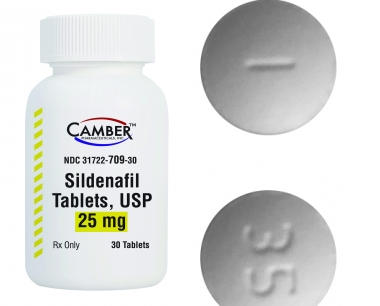Viagra is used to treat Erectile Dysfunction (ED) and Pulmonary Arterial Hypertension (PAH). It contains the active ingredient, Sildenafil. It works by relaxing the blood vessel walls, allowing blood flow to the penis more easily, which is an essential factor in getting and maintaining an erection.




Viagra is a blue, diamond-shaped tablet that comes in doses of 25mg, 50mg or 100mg.
You should follow the advice of a doctor when taking this medication. It is possible to buy it online without a prescription, but this is risky as the ingredients may be harmful, so we advise you to consult a doctor before taking Viagra. They will advise you on the correct dosage and whether any other medication you are taking may interfere with its effectiveness.
After taking the medication you should expect to see an effect after about 30 minutes. You will need to be sexually aroused in order for it to take effect.
But while countless men around the world (and their partners) have experienced the clear benefits of Viagra in their sex lives, there’s not as much awareness of how the “little blue pill” actually works. What does Viagra really do in the human body?
How fast does it work, and how long does it last? We decided to dig deeper and find out. If you’ve ever been curious about what Viagra can do, read on – you might be surprised at what you discover.

The manufacturers of Viagra recommend taking Viagra one hour before having sex. However, studies have suggested that it could start working even sooner than that. Some men were able to achieve an erection just 12 minutes after taking Viagra, although this wasn’t conclusively proven to be due to Viagra.
And while the maximum concentration of sildenafil in the blood isn’t reached until about an hour after taking it (and is potentially delayed by an additional hour if taken with food), it took a median of 27 minutes (with a range of 12–70 minutes) for men taking sildenafil to begin experiencing erections.
This was 23 minutes sooner than the median time of 50 minutes experienced by those who took a placebo.
The half-life of Viagra in the body is about four hours, meaning that every four hours after taking it, there’s only half as much of the drug left. However, even 10 to 12 hours after taking Viagra, men could still often achieve erections hard enough for penetration, though of a shorter duration. By 24 hours, all traces of Viagra in the blood are practically gone.

We’ve seen how quickly Viagra can work – but once it starts working, how long do erections typically last? In one study, an hour after taking Viagra, men reported being able to achieve erections lasting an average of 33 minutes. After eight hours, this decreased to 23 minutes, and by 12 hours, the mean duration of erections was reported to be 16 minutes.
In comparison, men who took a placebo found that they experienced erections lasting an average of seven minutes – less than half as long as among men who had taken Viagra 12 hours ago. Even long after the window of 30 minutes to four hours recommended by the manufacturers of Viagra, the drug clearly still has possible beneficial effects on erectile function.

Viagra is clearly an effective medication for some men, but how does it work on a cellular level? The mechanism by which Viagra allows men to achieve an erection more easily is fascinating. By inhibiting an enzyme known as PDE5 associated with muscle contraction in penile tissue, Viagra allows blood vessels to relax and expand, leading to increased blood flow into the penis.

So how do these molecular-level effects translate into bedroom performance? A study of nearly 4,000 men with erectile dysfunction who were then treated with sildenafil found a clear increase in the firmness of erections. Prior to taking Viagra, 58.7% of these men reported an erection hardness score of only 1 or 2, considered insufficient for penetration. However, after four weeks of treatment, 96.3% found they were able to obtain erections of hardness grade 3 or 4 – with 63.6% achieving grade 4 erections, the highest possible firmness. Without Viagra, a majority of these men would have had great difficulty having sex.

While Viagra was the first PDE5-inhibiting erectile dysfunction drug to be brought to market, a number of similar medications have since made their debut, such as Cialis, Levitra, and Spedra. But how do all these competing medications stack up? In a review of 82 trials covering over 47,000 patients, Viagra in a dose of 50mg was found to have a greater measured efficacy than all other PDE5-inhibiting medications when they were compared with a placebo.
Seeking Help for Your Sex Life
Viagra has achieved such widespread recognition and usage that it’s practically become synonymous with erectile dysfunction treatment. And while this has led to greater openness on the subject of impotence and sexual performance issues, discussion of sexual difficulties can still be a challenging topic for many. If you’ve been struggling with erectile dysfunction, visit Onlinedoctor.Superdrug.com for a discreet consultation with qualified medical professionals. You can receive expert advice in the comfort and privacy of your home, with any treatments quickly shipped to your door.
Sources
- https://edition.cnn.com/2013/03/27/health/viagra-anniversary-timeline/index.html
- https://www.drugs.com/stats/viagra
- https://bpspubs.onlinelibrary.wiley.com/doi/pdf/10.1046/j.0306-5251.2001.00034.x
- https://pubmed.ncbi.nlm.nih.gov/22386826/
- https://pubmed.ncbi.nlm.nih.gov/16422972/
- https://pubmed.ncbi.nlm.nih.gov/11879256/
- https://bpspubs.onlinelibrary.wiley.com/doi/pdf/10.1046/j.0306-5251.2001.00027.x
- https://pubmed.ncbi.nlm.nih.gov/17233779/
- http://labeling.pfizer.com/ShowLabeling.aspx?id=652#section-1
- https://www.medicines.org.uk/emc/medicine/1474
- https://pubmed.ncbi.nlm.nih.gov/23758451/
- https://pubmed.ncbi.nlm.nih.gov/24680453/
- https://pubmed.ncbi.nlm.nih.gov/25817916/
Fair Use
Feel free to share the images found on this page freely. When doing so, please attribute the authors by providing a link back to this page, so your readers can learn more about this project and the related research.